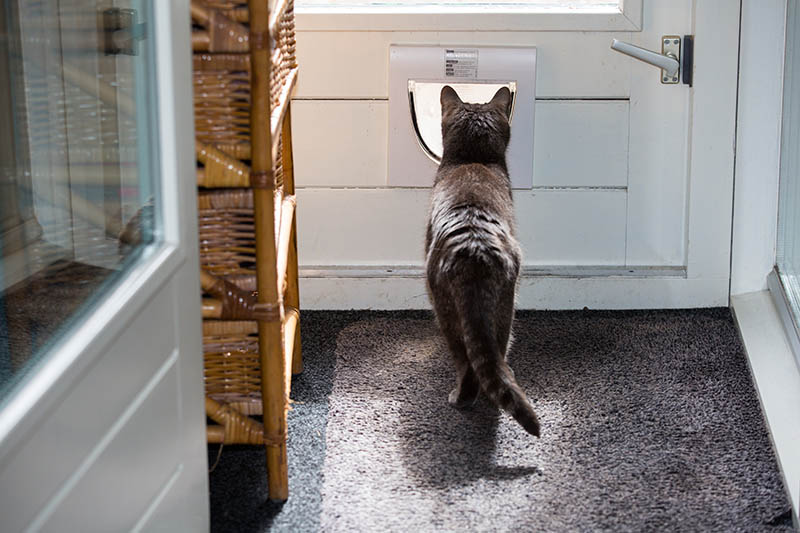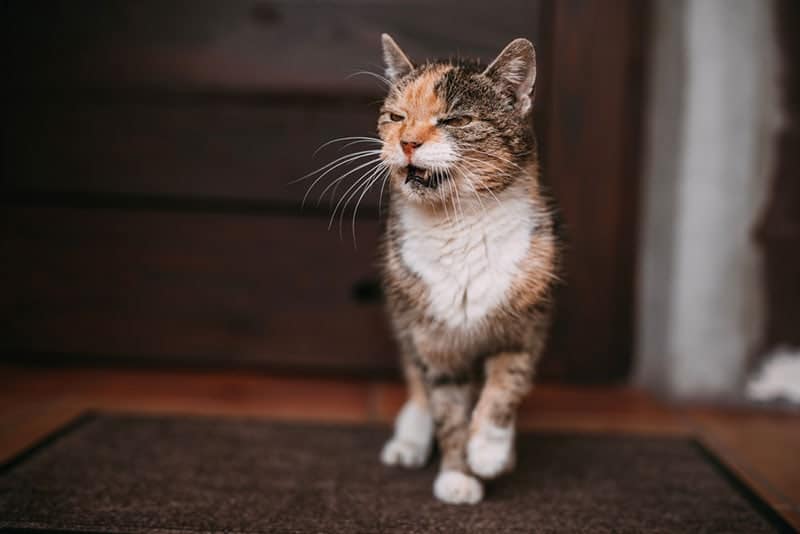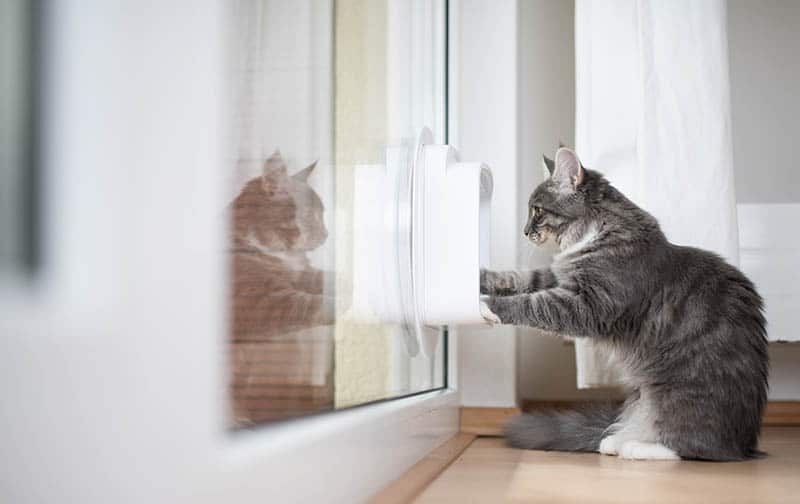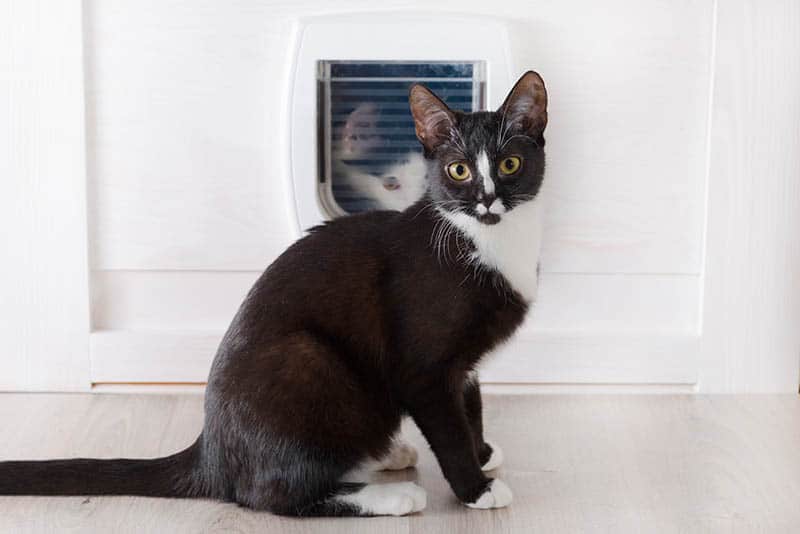Cats come with all kinds of cute quirks, including their guarding habits. No matter how aloof or indifferent our cats often appear, it’s always nice to see them standing guard at our bathroom or bedroom door.
But why do cats guard our doors? Are they protective, possessive, or unsure of what’s on the other side? We’ll help you understand your cat’s behavior with this look at six reasons why your cat is lurking around your front door.


The 6 Common Reasons Why Your Cat Is Guarding Your Door
1. Your Cat Wants Your Attention
While it may seem like your cat is guarding the door, their constant presence is often a simple call for attention. If your cat purrs loudly or paws on the other side of the door, it’s safe to assume he likes you.

2. Your Cat is Curious
Cats are inquisitive by nature, a trait that helps them thrive in the wild. By understanding more about their world, they can take better stock of their resources, assess threats and safe spaces, and feel secure in their space.
Closed doors are a mystery worth investigating. If your cat is trying to become familiar with the room, they may linger outside a door until they gain access. Outdoor cats, in particular, may have a stronger desire to explore when indoors and may exhibit more stress behaviors when they are not getting relief.
3. Your Cat Protects You
Cats are often thought of as solitary creatures, but they are perfectly willing and able to cooperate with others when it is mutually beneficial. As part of a close-knit group, you have a particular value on the cats they need to care for.
Many owners feel that their cats are protective, using their vocalizations as a primary sign of their alertness for intruders and other threats. Guarding your door may be your cat’s attempt to keep you safe and maintain their group of trusted companions.

4. It’s a Habit
If your cat sits there long enough, they can become accustomed to guarding your door. Using the bathroom at the same time every day or going to bed with the same ritual every night can cause your cat to get into the habit of staying out the door.
Once it becomes part of the routine, they will stick to it because they enjoy familiarity and predictability.
5. Your Cat Is Attached to You
Like dogs, cats can develop affection for their owners. Their attachment offers security and comfort. We often compare these relationships to a baby and its mother. The caregiver is a refuge in times of danger and a secure base that allows their dependents to explore their world healthily.
A central component of attachment styles is closeness, the desire to be close to the owner. As studies have shown, cat-owner relationships can be complex and quite different from dog-owner dynamics.
Depending on the owner’s emotional investment in the cat and the environment, cats may show more or less need to be close to their owner, which may explain why some tend to be more guarded. door than others.

Although individual differences exist to a high degree between cats, those with a high emotional investment in their owners have a greater need to stay close to them and are less accepting of others. . Relationships like this are usually dependent and involve less time outside and fewer individuals at home.
As with dogs, cats may be more likely to stay close or show separation-related stress if they don’t view their human as a secure base. Their owner may be distant or inconsistent in how they interact with their cat, causing the cat to distrust them or not rely on them as a reliable source of comfort.
Fortunately, it doesn’t mean your cat doesn’t trust you because they don’t stop you at the bedroom door every night. Cats with less need for closeness can also develop “friendship” attachments with owners.
They often have more cats and people in the house with whom they can interact, and their owners, although present, do not interact with them often, especially during playtime and feeding. Cats in these situations can develop positive relationships with their owners while still enjoying enough freedom to avoid constant contact.
6. Your Cat is Territorial
Cats are territorial creatures and exhibit aggressive behaviors when they feel threatened. Introducing new cats to the home can often trigger this, as they can create competition for resources.
In these instances, your cat may block access to food bowls, sleeping areas, or litter boxes. If there is a door that separates your cats from something they like, one can get into the habit of guarding it to keep the others out.
Should I stop my cat from guarding my door?

If your cat isn’t hurting anyone or anything by guarding the door, there’s little reason to stop the behavior. It may be part of the routine now, providing comfort to your cat. When your cat is guarding the door due to separation stress, you can help them relax by providing comfortable places to rest and hide alongside a healthy variety of toys and other enrichment devices.
As long as you don’t prevent them from doing anything, your cat can decide to spend his time as he likes. Door scratching and breaking is not allowed, and you don’t want to risk someone walking out of the room and accidentally stepping on them. Otherwise, hanging out by the door may be a harmless habit of a healthy cat.
A cat that legitimately guards the door to keep others away is a situation you need to address. Resource guarding destroys the relationship between your pets and is dangerous to the one your cat is trying to avoid in the room. In these cases, providing plenty of extra litter boxes, cat trees, hiding places, and other important features around the house can help keep your cats from feeling territorial.

Conclusion
Door-watching comes from many places, but certain situations can reveal why your cat is posting outside the room. There may be conflict between cats, or your cat may be wondering what’s going on in this unexplored area. You can also promote their proximity to your attachment style.
Whatever the reason, a cat guarding the door is one of the many idiosyncrasies that make them happy at home. Until it becomes a problem, you can accept it as another reason to love your cat as an individual.
Featured Image Credit: PongsakA, Shutterstock


